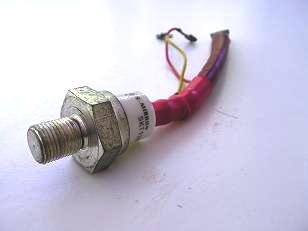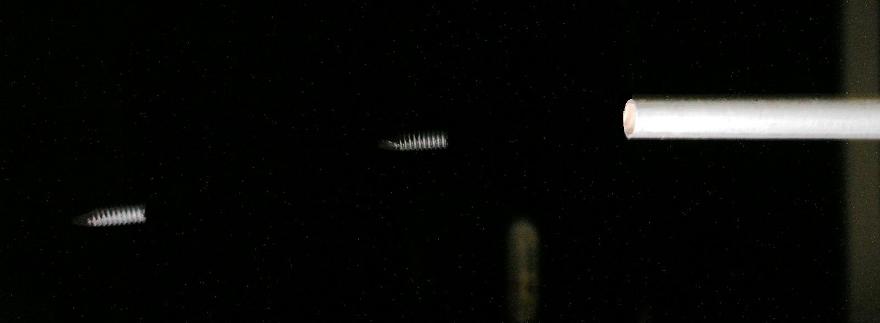Did
you ever, as a young child, do the "wind lots of
turns of wire around an iron rod and apply power from
a battery" experiment? If you missed out (oh dear,
you poor thing), basically it made an electromagnet,
and could pick up like a couple of paperclips or something
similarly pathetic.
The
turns of wire create a magnetic field, and the more
current that is fed through these turns of wire, the
greater the magnetic field. Simple. |
|

When
the resistance is too low, current will increase to
a point where the power supply or the fuse will just
blow up.
|
Herein
lies the workings behind a coilgun, a device designed
to propel metal 'bullets' using no gas, no gunpowder
and no moving parts - only magnetism.
The problem
here is that most power supplies you would have used
for the paperclip device would only be capable of say,
2 or 3A maximum. So even if you had less turns (less
resistance = more current), your current would peak
at around 3A, and simply stop. |
So
the next logical question would be, where does one obtain
a power supply that can provide close to unlimited current?
The
answer is, you can't. But you can get one that supplies
almost unlimited current for a very short duration,
say in the vicinity of 10ms. The solution is a capacitor,
of course. Preferably one with low ESR (equivalent series
resistance), to allow higher peak current.
The
one that I use in the coilgun is an inverter grade,
relatively low ESR capacitor sourced from our good friend
eBay. |

Coilgun capacitor
- there is a standard AA battery for scale.
|
|
For a bit
of a reality check... a capacitor such as this one,
which stores 3900uF at 400V, can store up to 312J of
energy, which is theoretically able to kill a person
20 times over. It can also provide a discharge current
of over 2000A, a factor of 80 times greater than what
a standard kitchen oven would draw at any given time.
So, needless
to say, capacitors can be quite dangerous in the wrong
hands. Please be careful! |
The
idea of the coilgun then, if you haven't already realised,
is to discharge this capacitor into a carefully tuned
coil so that it produces an intense magnetic field.
This magnetic field will then attract a length of steel
rod (the bullet), and accelerate it to a very high velocity.
As
the coil will only be energized for a few milliseconds,
the bullet is sucked into the coil at a very high speed.
At this time, the magnetic field collapses, and as a
result the moving 'bullet' continues to move out of
the barrel at high speed. |

My MS Paint skills
at work |
|
All wonderful
for the theory. But what about reality? Well here is
my coil + barrel. My barrel is just some random piece
of aluminium tubing that fits snugly inside the coil
former. There is nothing glamous-looking about this
setup, that's for sure.
The wood
blocks secure the coil, and the red tape covers a protective
layer of iron laminations that are wrapped around the
coil. In fact, these laminations assist in strengthening
the magnetic field within the coil. |
Here's
a different view of the same thing. Pretty self explanatory
I think. Again, there is nothing nice about the look
of this thing. But hey, if you're a regular reading
of this site then you'll know that ain't my style anyway. |
|
|
And a
view down the barrel. Very menacing. Below the barrel
you can see the end of the big capacitor. I'll show
you what's inside later. But first, the bullets. |
The
bullets, I admit, are not made out of the ideal material.
First I cut 2cm bits off a long steel thread, then one
by one I sharpened them with an angle grinder.
The
thread actually reduces the amount of iron, so that
doesn't really help. I hoped, though, that this might
improve the aerodynamic stability. Just a theory... |
|

Semikron stud SCR,
2100A surge
|
So how
do we go about dumping the capacitor's energy into this
coil? Quite clearly we need some kind of switch, but
you can look up a donkeys arse (so to speak) until you
find a mechanical one, because there is no such thing
as a small push button switch that can handle 2000A+.
A more practical
way is a to use a semiconductor, such as a silicon controlled
rectifier (SCR) which effectly acts as a high current
switch. However these don't come cheap, but I scrounged
around and found a supplier that sold used SCRs for
$5.
This particular
one was a Semikron brand stud SCR, which can handle
a whopping 2100A surge current. |
I
also needed a hefty protection diode, because the voltage
kickback from the coil would potentially destroy the
capacitor, and the diode would be employed to absorb
this kick. The diode chosen was slightly overkill but
is also a stud variety.
Here's
a picture of the internal setup with parts labeled.
The rectifier diodes serve to convert the 300v AC supply
into an equivalent DC voltage to charge the capacitor. |
|

Entire coilgun setup
|
The only
other thing I haven't mentioned is the DC-AC inverter.
Because I wanted to use a battery (since when did guns
carry around a power cable?), I had to have something
to boost the 12VDC battery into at least 300VAC. This
was achieved using an ordinary inverter circuit, such
as the one used in my fluoro
tube driver.
Originally
I had the bottom end of a drill as the handle, with
the drill battery powering the gun. But after a while
the battery broke, and I was forced to dismantle the
drill handle and ended up using it for the new improved
night vision module. |
This
mechanism is something I came up with to ensure that
the bullets are always loaded in the optimal position
prior to shooting. It resembles, somewhat, the bolt
of a gun, and configured so that the bullets are in
exactly the right position behind the coil after the
bolt is 'armed'. |
|
|
So... results?
Mmm, nice
clean holes through coke cans.
Using a microphone
and a computer, I recorded a shot over 2 meters or so,
and used the delay to calculate the velocity. Turns
out the bullet velocity is around 30m/s, or just over
100km/h. |
And
a shot through a ceramic statue's head from a few meters
away.
Actually
this was given to me as a present by Nick. Unfortunately,
this statue happened to be the first thing I could find.
Thank you so much Nick... hahaha. |
|
|
After
a fun day of sharp shooting... a box of broken CD's,
cases, and other random stuff. I've also broken a few
tiles and put small dents in the wall (oops). |
|
| Using
the Penguin's Lab stroboscopic equipment detailed elsewhere,
I attempted to capture images of the bullet coming out
of the barrel at high speed. |

Captured
at ~20Hz flash rate. The power to the coilgun was
turned down almost all the way because anything faster
than that would not have been captured on time.
|

The bullets
trajectory at extremely low firing power. Again captured
at ~20Hz flash rate. I'm actually surprised at how
the bullet doesn't swerve and turn and do all sorts
of funny things in the air, because some of the impacts
in the coke cans suggest that the bullets have hit
the can side on.
|